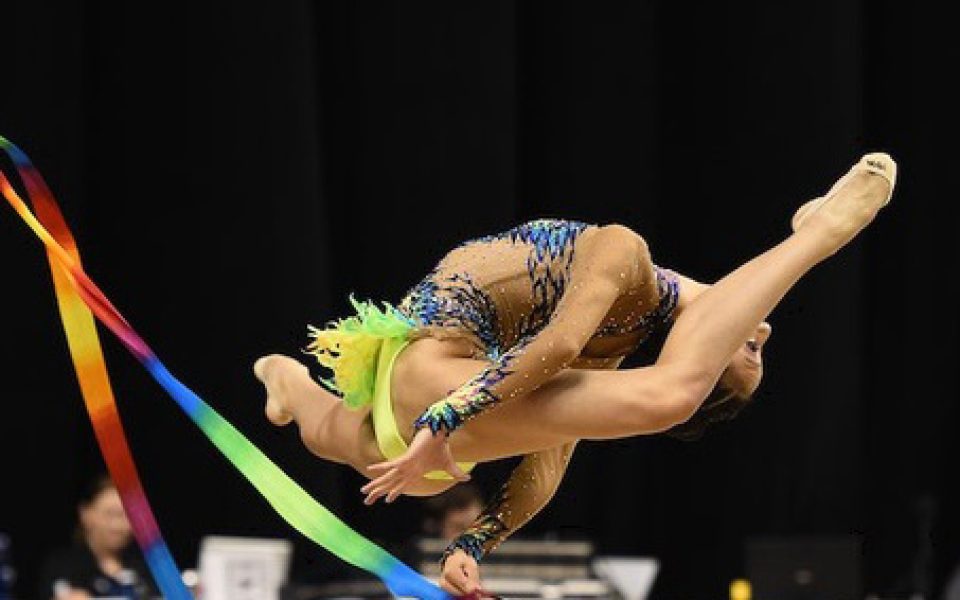Heather Chan beamed with confidence during the USA Gymnastics Championship elite finals at the Greensboro Coliseum on Saturday. She was a rainbow, from her peacock-like leotard featuring bold yellows and greens to her ribbon featuring every color of the spectrum. She maintained a bright smile for the judges and the audience throughout her incredible twirls and her clutch catches of the baton, thrown impossibly high in the air, caught in rhythm with late-Romantic orchestral music and the claps of the crowd.
As I watched the competition, I was reminded of a debate I had with my sister Hannah long ago.
Hannah danced ballet for years, and I remember arguing with her that ballet could be a sport.
Hannah denied this vehemently. She maintained that, while ballet took strength, skill, practice and concentration comparable to any professional sport, ballet was never sport and never would be.
Maybe it’s because I was never meant to be a “sporting” person — I have terrible ankles, bad back pain, hamstrings of steel and the nerves of a squirrel on speed — but I still found my sister’s early passion to be a form of elite athleticism.
I’ve watched the Olympic gymnastics competitions with awe for years without really grasping what the hell is going on. Men and women perform feats of strength, poise and artistry on hoops the size of small plates, or bars the width of VHS tapes, and hopefully dismount on their own two feet without an apparent bead of sweat. It’s enthralling.
Watching the tumbling and trampoline routines in this championship left me stunned and speechless. I don’t fully understand how judges can catch the exact moves and skills these men and women performed. They bound like bipedal deer for a second, then twist their body into impossible positions with the speed and accuracy of a bullet flying out of a rifled barrel. It’s poetry in motion, but the quickest, most stilted poetry imaginable.
Though the tumbling and trampoline gymnasts stunned me, I saw displays of talent which boggled my mind while watching the routines of the rhythmic and acrobatic gymnasts.
Acrobatic gymnastics might demand more concentration — and in that concentration, more physical fortitude — than any sport I’ve ever seen in my life.
Duos or trios of young women would dance and tumble across a stage a few dozen feet across, cartwheeling and somersaulting in sync with the rhythm of their soundtracks, which ranged from bombastic classical music to sitar-twinged techno.
The tops — the tiny, youngest members of these teams — contorted themselves atop their partners into rings and other absurd shapes.
The most popular acrobatic pyramid amongst trios seemed to be the “needle” — a seeming Eiffel Tower wherein the base bends over backward and the middle woman serves as a triangular mount for the top, who strikes whichever angular pose they decide will bring their team the most points.
But one group brought style to a new pinnacle.
While a Spanish theme played on a lute, two larger young women, Connerney and Dyer, formed a triangular arch while standing on their hands, their feet meeting at the apex, while the lighter top, Bentov-Lagman, performed a handstand on the tips of their upstretched feet — the only true Eiffel Tower.
These three women eventually placed first in the junior elite group finals.
While the acrobatic exercises demanded extreme athleticism alongside impressive artistry, the rhythmic gymnastics routines presented the vice-versa situation. I connected more with this side of gymnastics — especially when featuring batons.
Nearly every move those rhythmic gymnasts performed reminded me of watching my sister on War Memorial Auditorium’s stage as she danced for Greensboro’s holiday presentation of Tchaikovsky’s The Nutcracker.
And they did it all while twirling batons with six-meter-long ribbons attached to the end, achieving a kaleidoscopic effect with the colored cloth.
Aliya Protto possessed the most dancer-esque build, tall with long limbs drawn against a thin but strong frame. While she did tangle the ribbon on her head right off the bat, she showed a ballerina’s finesse and control in her leaps and turns.
But there can be only one winner, and Laura Zeng deserved it beyond any doubt.
Zeng possessed incredible poise and balance despite the difficulty of her routine. She engaged eye contact with both the audience and the judges simultaneously, swirling her purple, blue and green ribbon around her bright-red, sequined outfit to the pounding intensity of clacking percussion. She ended her routine by tossing her baton high in the air with her foot before flinging it back and forth for a flourishing finish.
From my ignorant layman’s perspective, the performance seemed utterly flawless. The judges thought so, too.
As my sister quickly pointed out years ago, there’s definitely a difference between the art of ballet and the sport of gymnastics, but it’s a slim difference, in the same way that not all rhombuses are squares: gymnastics are scored. But art isn’t meant to be a competition.
Join the First Amendment Society, a membership that goes directly to funding TCB‘s newsroom.
We believe that reporting can save the world.
The TCB First Amendment Society recognizes the vital role of a free, unfettered press with a bundling of local experiences designed to build community, and unique engagements with our newsroom that will help you understand, and shape, local journalism’s critical role in uplifting the people in our cities.
All revenue goes directly into the newsroom as reporters’ salaries and freelance commissions.



Enjoyed this too! Love your work and you expression of it.